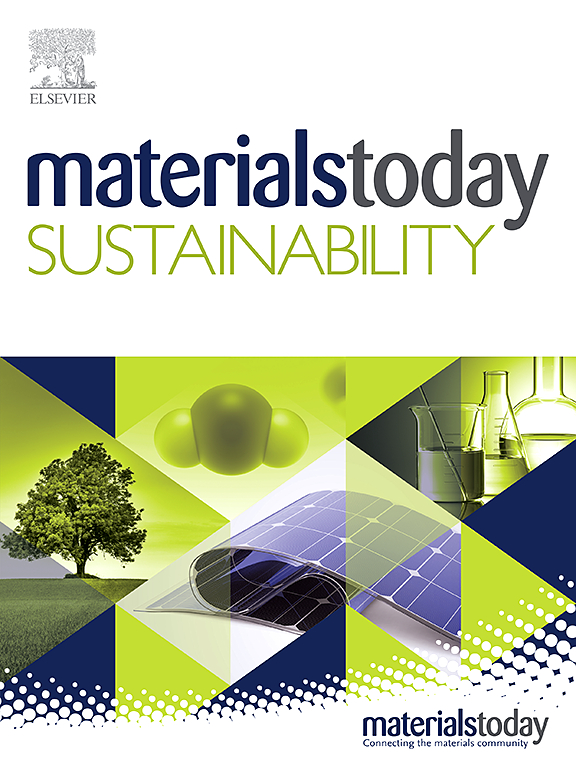Promotional role of methanol and CO2 in carbon dioxide-rich syngas hydrogenation over slurry reactor utilizing combustion induced Cu-based catalysts
IF 7.1
3区 材料科学
Q1 GREEN & SUSTAINABLE SCIENCE & TECHNOLOGY
引用次数: 0
Abstract
Converting CO2 to methanol directly remains a hurdle due to catalyst and thermodynamic limitations. This study proposes a solution: using Cu–MgO–CeO2 (CuMgCe) catalysts (synthesized by solvent combustion) in slurry reactors for methanol formation through methanol-assisted CO2-rich syngas hydrogenation. The key innovation lies in the catalyst design by focusing on CO2-rich syngas mixtures, we establish a crucial link between catalyst structure and its activity (structure-activity relationship). Our CuMgCe catalyst achieves a space-time yield of 646 gMeOH/kgcat-h−1, exceeding lab-made industrial catalysts (608.5 gMeOH/kgcat-h−1). This yield is further boosted by 5% through an ingenious method - adding initial methanol, which promotes formate intermediates for enhanced productivity. In-depth analysis reveals CO2 formation during CO-TPD-MS and CO-TPR-MS, generating highly active surface species (CO2δ−) ideal for forming formate intermediates. In-situ DRIFTS confirms the dominance of this formate pathway on CuMgCe for selective methanol synthesis. A mechanistic study sheds light on the synergistic effect of MgO and CeO2 in the lab-prepared CuMgCe catalyst. This synergy promotes methanol formation during CO2-cofed syngas conversion. This research paves the way for highly efficient and selective catalysts for CO2 utilization in slurry reactor technology, offering a significant step towards cleaner fuel production.

燃烧诱导cu基催化剂对浆体反应器上富二氧化碳合成气加氢的促进作用
由于催化剂和热力学的限制,将二氧化碳直接转化为甲醇仍然是一个障碍。本研究提出了一种解决方案:在浆料反应器中使用Cu-MgO-CeO2 (CuMgCe)催化剂(溶剂燃烧合成),通过甲醇辅助富co2合成气加氢制甲醇。重点创新在于催化剂设计,着眼于富含二氧化碳的合成气混合物,我们建立了催化剂结构与其活性之间的关键联系(构效关系)。我们的CuMgCe催化剂实现了646 gMeOH/kgcat-h−1的时空产率,超过了实验室制造的工业催化剂(608.5 gMeOH/kgcat-h−1)。通过一种巧妙的方法,该收率进一步提高了5% -添加初始甲醇,促进甲酸酯中间体提高生产率。深入分析表明,CO-TPD-MS和CO-TPR-MS过程中CO2的形成,产生了高活性的表面物质(CO2δ−),是形成甲酸酯中间体的理想物质。原位漂移证实了这种甲酸途径在选择性甲醇合成中的优势。机理研究揭示了MgO和CeO2在实验室制备的CuMgCe催化剂中的协同作用。这种协同作用促进了在co2 - co_2合成气转化过程中甲醇的形成。该研究为浆液反应器技术中高效、选择性的CO2利用催化剂铺平了道路,为清洁燃料生产迈出了重要的一步。
本文章由计算机程序翻译,如有差异,请以英文原文为准。
求助全文
约1分钟内获得全文
求助全文
来源期刊

Materials Today Sustainability
Multiple-
CiteScore
5.80
自引率
6.40%
发文量
174
审稿时长
32 days
期刊介绍:
Materials Today Sustainability is a multi-disciplinary journal covering all aspects of sustainability through materials science.
With a rapidly increasing population with growing demands, materials science has emerged as a critical discipline toward protecting of the environment and ensuring the long term survival of future generations.
 求助内容:
求助内容: 应助结果提醒方式:
应助结果提醒方式:


